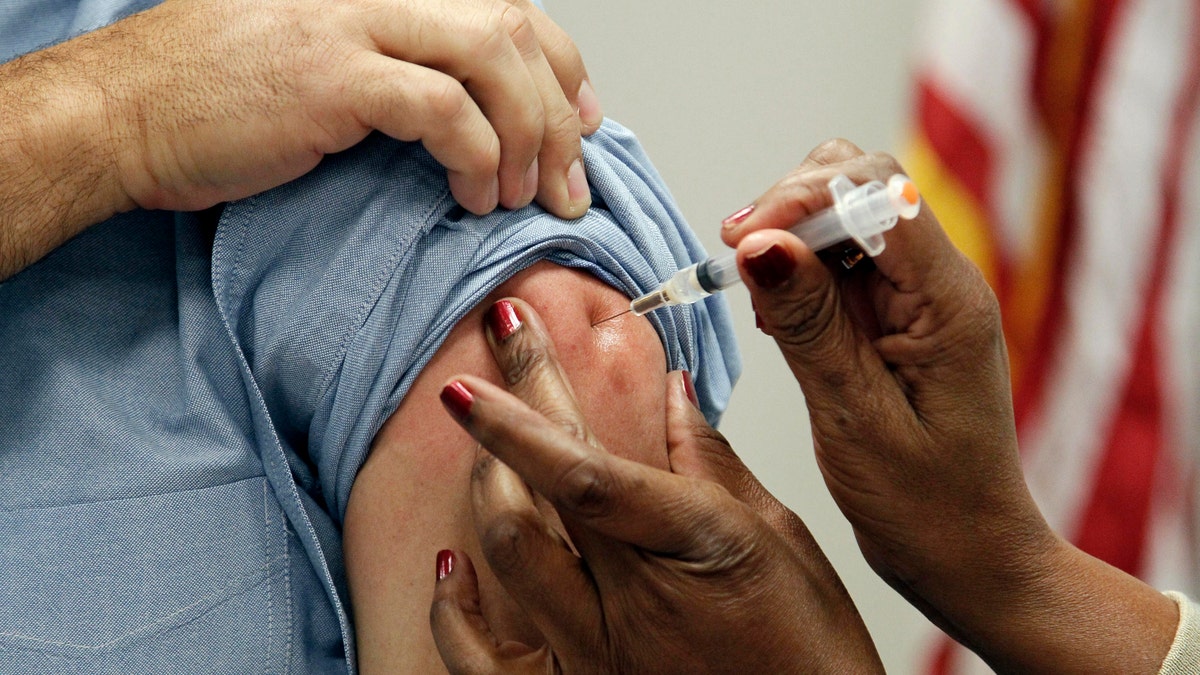
Oct. 17, 2012: This file photo shows a patient getting a flu shot in Jackson, Miss. (AP)
This year’s flu vaccine is offering moderate protection against the main family of viruses causing illness, data released Thursday by the Centers for Disease Control and Prevention show.
The data comes as what has been a pretty active flu season is near its apex in many parts of the country.
“We won’t know when the peak has occurred until we’ve passed it and have a couple of weeks to look back,” said Lynnette Brammer, head of domestic influenza surveillance at the CDC. “We hopefully are approaching the peak but we may not be there yet.”
Overall, getting a flu shot cut one’s risk of contracting flu and needing to see a doctor by 48 percent this season, when the effectiveness of the various components of the vaccine were assessed together, according to the report published in the CDC’s online journal Morbidity and Mortality Weekly Report.
Far and away the most common cause of influenza so far this year is the influenza A virus family known as H3N2. Seasons when H3N2 viruses dominate are typically harsh because the virus is especially hard on older adults. Older adults also get less benefit from flu vaccines than healthy younger people.
As well, the H3N2 component of the flu vaccine has not worked as well as other components in recent years. Flu vaccines are combination vaccines, protecting against three and sometimes four different flu strains.
Mixed effectiveness
This year is not an exception. The CDC data, drawn from five surveillance sites across the country, suggest that the H3N2 component of the 2016-17 flu vaccine offered about 43 percent protection against medically attended influenza.
To put that in context, the influenza B component of the vaccine this year appears to offer about 73 percent protection. The CDC could not estimate vaccine effectiveness for the influenza A H1N1 component of the vaccine because those viruses haven’t played much of a role so far this winter.
“It’s not as good as we would like to see, and we’ve seen higher for some of the seasons — more for H1N1 and for [flu] B,” said Brendan Flannery, an epidemiologist with the CDC’s influenza division.
“But for H3N2, it’s as good as we have seen for some of the H3N2 seasons that have been well matched.”
In the last H3N2-dominant flu season, in 2014-15, the target virus in the vaccine was not well matched to the viruses that were making people sick. That year data suggested the vaccine offered virtually no protection against H3N2 viruses.
The need for better vaccines
“Forty percent to 50 percent is a lot better than zero, but what it really begs the question is: Why are we not working hard to get new and better flu vaccines?” said Michael Osterholm, director of the University of Minnesota’s Center for Infectious Diseases Research and Policy and a long-time advocate for the development of more effective flu vaccines.
“Last year we spent over a billion dollars researching new HIV vaccines — an amount that I think is an important investment. But the best estimate we can come up with is we only spend about $35 million globally on … research on new game-changing flu vaccines.’’
The US findings mesh with vaccine effectiveness results seen elsewhere this season.
Last week Canadian researchers reported they are seeing about 42 percent protection from the H3N2 component of the vaccine north of the border. And European scientists reported vaccine effectiveness of 38 percent for H3N2 on Thursday.
Jacqueline Katz, deputy director of the CDC’s influenza division, said a theory behind the poor performance of the H3N2 component of the vaccine relates to the way flu vaccine is produced.
Most influenza vaccine is produced in hen’s eggs; the viruses have to adapt to grow in eggs. That’s true of all families of flu but for some reason the H3N2 viruses adapt in ways that introduce important differences. In essence, the viruses produced in the eggs are different from the viruses circulating in people and don’t adequately prime immune systems to recognize and fend off those viruses. In some years those differences are more pronounced than others.




















